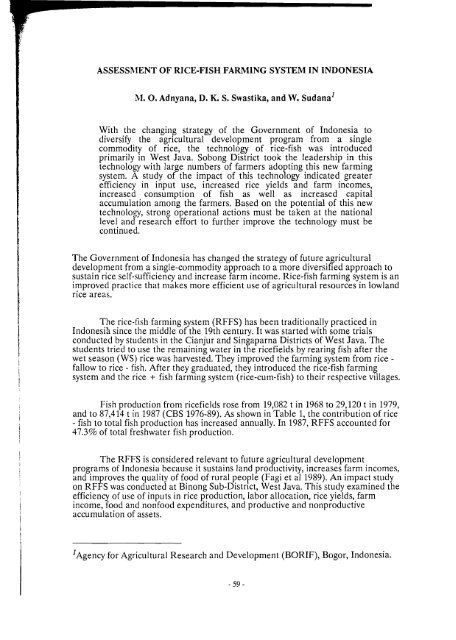systems research - the IDRC Digital Library - International ...
systems research - the IDRC Digital Library - International ...
systems research - the IDRC Digital Library - International ...
You also want an ePaper? Increase the reach of your titles
YUMPU automatically turns print PDFs into web optimized ePapers that Google loves.
ASSESSRIENT OF RICE-FISH FARMING SYSTEM IN INDONESIA<br />
h1.O. Adnyana, D. K. S. Swastika, and W. sudanal<br />
With <strong>the</strong> changing strategy of <strong>the</strong> Government of Indonesia to<br />
diversify <strong>the</strong> agricultural development program from a single<br />
commodity of rice, <strong>the</strong> technology of rice-fish was introduced<br />
primarily in West Java. Sobong District took <strong>the</strong> leadership in this<br />
technology with large numbers of farmers adopting this new farming<br />
system. A study of <strong>the</strong> impact of this technology indicated greater<br />
efficiency in input use, increased rice yields and farm incomes,<br />
increased consumption of fish as well as increased capital<br />
accumulation among <strong>the</strong> farmers. Based on <strong>the</strong> potential of this new<br />
technolo~, strong operational actions must be taken at <strong>the</strong> national<br />
level and <strong>research</strong> effort to fur<strong>the</strong>r improve <strong>the</strong> technology must be<br />
continued.<br />
The Government of Indonesia has changed <strong>the</strong> strategy of future agricultural<br />
development from a single-commodity approach to a more diversified approach to<br />
sustain rice self-sufficiency and increase farm income. Rice-fish farming system is an<br />
improved practice that makes more efficient use of agricultural resources in lowland<br />
rice areas.<br />
The rice-fish farming system (RFFS) has been traditionally practiced in<br />
IndonesiB since <strong>the</strong> middle of <strong>the</strong> 19th century. It was started with some trials<br />
conducted by students in <strong>the</strong> Cianjur and Singaparna Districts of West Java. The<br />
students tried to use <strong>the</strong> remaining water in <strong>the</strong> ricefields by rearing fish after <strong>the</strong><br />
wet season (WS) rice was harvested. They improved <strong>the</strong> farming system from rice -<br />
fallow to rice - fish. After <strong>the</strong>y graduated, <strong>the</strong>y introduced <strong>the</strong> rice-fish farming<br />
system and <strong>the</strong> rice + fish farming system (rice-cum-fish) to <strong>the</strong>ir respective villages.<br />
Fish production from ricefields rose from 19,082 t in 1968 to 29,120 t in 1979,<br />
and to 87,414 t in 1987 (CBS 1976-89). As shown in Table 1, <strong>the</strong> contribution of rice<br />
- fish to total fish production has increased annually. In 1987, RFFS accounted for<br />
47.3% of total freshwater fish production.<br />
The RFFS is considered relevant to future agricultural development<br />
programs of Indonesia because it sustains land productivity, increases incomes,<br />
and improves <strong>the</strong> quality of food of rural people (Fagi et a1 1989). An impact study<br />
on RFFS was conducted at Binong Sub-District, West Java. This study examined <strong>the</strong><br />
efficiency of use of inputs in rice production, labor allocation, rice yields, farm<br />
income, food and nonfood expenditures, and productive and nonproductive<br />
accumulation of assets.<br />
l ~ ~ efor n Agricultural c ~ Research and Development (BORIF), Bogor, Indonesia.<br />
- 59 -
















